
Primulales was an order of flowering plants. This order was recognized in several systems with little variation in circumscription. In the classification system of Dahlgren the Primulales were in the superorder Primuliflorae. In the 1981 version of the Cronquist system it was an order placed in subclass Dilleniidae with the following circumscription:

Anagallis arvensis, commonly known as the scarlet pimpernel, red pimpernel, red chickweed, poor man's barometer, poor man's weather-glass, shepherd's weather glass or shepherd's clock, is a species of low-growing annual plant with brightly coloured flowers, most often scarlet but also bright blue and sometimes pink. The native range of the species is Europe and Western Asia and North Africa. The species has been distributed widely by humans, either deliberately as an ornamental flower or accidentally. A. arvensis is now naturalised almost worldwide, with a range that encompasses the Americas, Central and East Asia, the Indian Subcontinent, Malesia, the Pacific Islands, Australasia and Southern Africa.

The Primulaceae, commonly known as the primrose family, are a family of herbaceous and woody flowering plants including some favourite garden plants and wildflowers. Most are perennial though some species, such as scarlet pimpernel, are annuals.
Fijians are a nation and ethnic group native to Fiji, who speak Fijian and share a common history and culture.
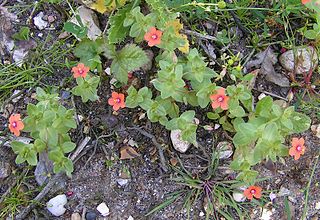
Anagallis is a genus of about 20–25 species of flowering plants in the family Primulaceae, commonly called pimpernel. The scarlet pimpernel referred to in literature is part of this genus. The botanical name is from the Greek ana and agállein, and it refers to the opening and closing of the flowers in response to environmental conditions.
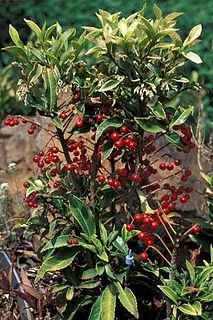
Myrsinoideae is a subfamily of the family Primulaceae in the order Ericales. It was formerly recognized as the family Myrsinaceae, or the myrsine family, consisting of 35 genera and about 1000 species. It is widespread in temperate to tropical climates extending north to Europe, Siberia, Japan, Mexico, and Florida, and south to New Zealand, South America, and South Africa.

Balanops is a group of flowering plants described as a genus in 1871. The nine species are trees or shrubs, found in New Caledonia, Fiji, Vanuatu, and northern Queensland. They are dioecious, with separate male and female plants.
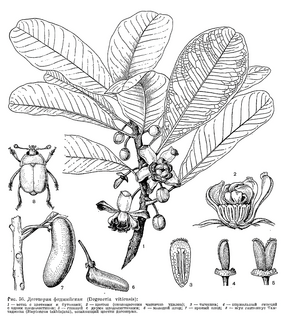
Degeneria is a genus of flowering plants endemic to Fiji. It is the only genus in the family Degeneriaceae. The APG IV system of 2016, recognizes this family, and assigns it to the order Magnoliales in the clade magnoliids.
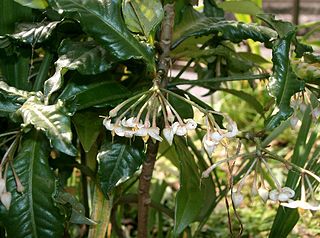
Ardisia is a genus of flowering plants in the family Primulaceae. It was in the former Myrsinaceae family now recognised as the myrsine sub-family Myrsinoideae. They are distributed in the Americas, Asia, Australia, and the Pacific Islands, mainly in the tropics. There are over 700 accepted species. One species, Ardisia japonica is one of the 50 fundamental herbs in traditional Chinese medicine.
Cyphosperma is a genus of flowering plants in the family Arecaceae, native to various islands of the Pacific. It contains the following species:

Veitchia is a genus of flowering plant in the family Arecaceae.

Maesa is a genus of flowering plants. It is placed in the family Primulaceae, subfamily Maesoideae, for which it is the sole genus (monotypic). Previously it ws placed in Myrsinaceae, or in a family of its own, Maesaceae. There are about 100 species, the majority of which occur in Malesia, New Guinea, western Asia and the Pacific Islands.

Parathesis is a genus of flowering plants in the family Primulaceae. There are about 95 species distributed from Mexico to South America and the Caribbean. Plants of this genus can be distinguished by glandular papillae on the lobes of the flower corolla and bright yellow anthers.
Tapeinosperma campanula is a species of plant in the family Primulaceae. It is endemic to New Caledonia.

Ficus obliqua, commonly known as the small-leaved fig, is a tree in the family Moraceae, native to eastern Australia, New Guinea, eastern Indonesia to Sulawesi and islands in the southwestern Pacific Ocean. Previously known for many years as Ficus eugenioides, it is a banyan of the genus Ficus, which contains around 750 species worldwide in warm climates, including the edible fig. Beginning life as a seedling, which grows on other plants (epiphyte) or on rocks (lithophyte), F. obliqua can grow to 60 m (200 ft) high and nearly as wide with a pale grey buttressed trunk, and glossy green leaves.
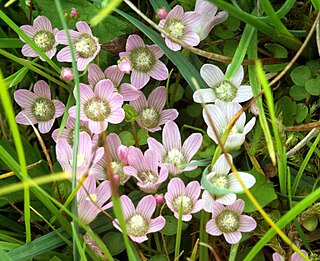
Anagallis tenella, known in Britain as the bog pimpernel, is a low growing perennial plant found in a variety of damp habitats from calcareous dune slacks to boggy and peaty heaths in Eurasia. In the United Kingdom it is mostly restricted to the western half of the country, although it was more common in the east before land drainage and intensification of farming in that area.

Lysimachia foemina is commonly known as blue pimpernel or poor man's weatherglass, and was formerly called Anagallis foemina. It is a low-growing annual herbaceous plant in the genus Lysimachia of the family Primulaceae. In a comparison of DNA sequences, L. foemina was shown to be most closely related to L. monelli. It had been thought by many to be closest to L. arvensis, and some authors had even included L. foemina as a subspecies of L. arvensis, as Anagallis arvensis subsp foemina. These three species were among several transferred from Anagallis to Lysimachia in a 2009 paper.
John James Pipoly III is an American botanist and plant collector. He is a leading expert on the systematics and taxonomy of the genus Ardisia within the Myrsinoideae, as well as the family Clusiaceae.
Mark James Elgar Coode is a British botanist, taxonomic author and authority in the field of Elaeocarpaceae.
Tapeinosperma pachycaulum is a palm-like, pachycaul tree historically in the family Myrsinaceae, but now often grouped with the primroses (Primulaceae). It is endemic to the Solomon Islands where it is called Sirikunu. It is a small rainforest tree to 16.5 feet in height and only to four inches in thickness. It is perhaps most noteworthy for its very large leaves, up to 3 ft 6in in length for the lamina (blade), with an additional ten inches (25 cm) for a petiole (stalk) Their width can be up to sixteen inches. The flowers can be red or yellow.













